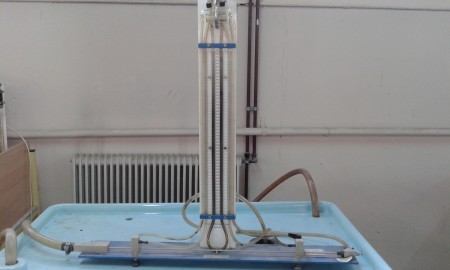
Use in Fluid Dynamics II lab.
The Friction Loss in a Pipe apparatus allows students to study the change in the laws of resistance for laminar to turbulent flow and find the critical Reynolds number. The apparatus shows the flow transition point from laminar to turbulent, and is ideal for demonstrations as well as student experiments. The equipment is a small-bore, straight test pipe on a base plate. It works with Gravimetric or Volumetric Hydraulic Benches.
Static pressure tappings upstream and downstream of the test pipe connect to a water manometer and a pressure gauge. The back panel holds the pressure gauge and a water manometer with calibrated scales. The water manometer measures lower differential pressures in the laminar and lower turbulent flow regions (just above the critical Reynolds Number). The pressure gauge measures higher pressures in the turbulent flow region. The water manometer includes an air valve and hand-pump. The hand-pump adjusts the datum of the water manometer where necessary. A valve at the downstream tapping allows students to isolate the water manometer during the higher flow tests. A precision needle valve downstream of the test pipe accurately controls flow rate.
To perform experiments, students stand the apparatus on the hydraulic bench and fit the header tank (supplied). For low flow rate experiments, the header tank supplies the test pipe. For higher flow rate experiments, the hydraulic bench supplies the test pipe directly. Students set the flow rate, measuring it by timing the collection of water in a measuring vessel.
Students take readings of temperature from a thermometer (not included) and readings of head from the manometer or the pressure gauge. They then use the results to produce charts to help compare actual results with theory.
